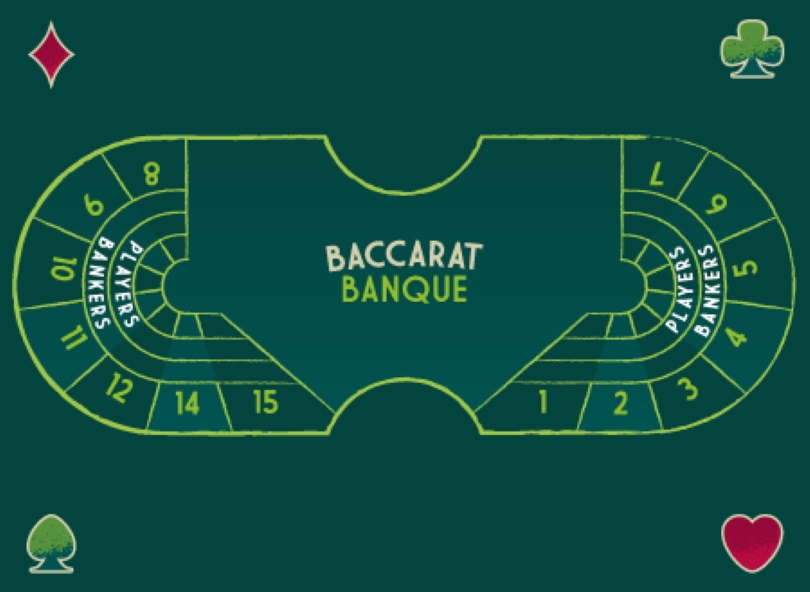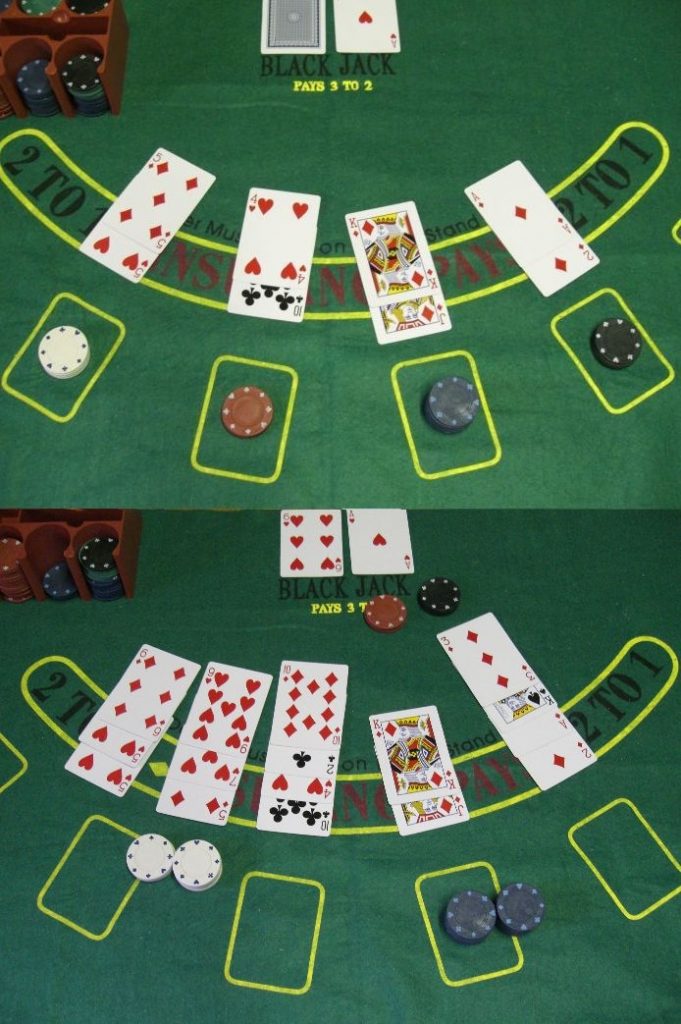Este artigo é um complemento ao artigo anterior: “Variações de regras e efeitos na vantagem da casa —- Blackjack(Parte 1)“. Se você não leu o artigo anterior, leia-o primeiro.
Redivisão
Se as cartas de uma mão pós-dividida tiverem o mesmo valor, a maioria dos jogos permite que o jogador divida novamente, ou “divida novamente”. O jogador faz mais uma aposta e o dealer separa o novo par, distribuindo mais uma carta para cada um como antes. Alguns jogos permitem redivisão ilimitada, enquanto outros podem limitá-la a um certo número de mãos, como quatro mãos (por exemplo, “redivisão para 4”).
Acertar/repartir ases divididos
Depois de dividir os ases, a regra comum é que apenas uma carta será distribuída para cada ás; o jogador não pode dividir, dobrar ou receber outro golpe em nenhuma das mãos. As variantes das regras incluem permitir a repartição de ases ou permitir que o jogador acerte ases divididas. Jogos que permitem que os ases sejam divididos novamente não são incomuns, mas aqueles que permitem ao jogador acertar ases divididos são extremamente raros. Permitir que o jogador acerte mãos resultantes de ases divididos reduz a vantagem da casa em cerca de 0,13%; permitir a repartição de ases reduz a vantagem da casa em cerca de 0,03%. Observe que uma carta de valor dez distribuída sobre um ás dividido (ou vice-versa) não será contada como Blackjack , mas como um soft 21.

Não há dobro após divisão
Após uma divisão, a maioria dos jogos permite dobrar nas novas mãos de duas cartas. Proibir a duplicação após uma divisão aumenta a vantagem da casa em cerca de 0,12%.
Duplo em 10/09/11 ou apenas 11/10
De acordo com a “regra de Reno”, dobrar só é permitido em totais difíceis de 9, 10 ou 11 (sob uma regra europeia semelhante, apenas 10 ou 11). Caso contrário, a estratégia básica exigiria alguma duplicação com hard 9 e soft 13-18, e os jogadores avançados podem identificar situações em que dobrar em soft 19-20 e hard 8, 7 e até 6 é vantajoso. A regra de Reno impede que o jogador tire vantagem do double-down nestas situações e, assim, aumenta a perda esperada do jogador. A regra de Reno aumenta a vantagem da casa em cerca de 0,1% e a sua versão europeia em cerca de 0,2%.
Sem carta fechada e OBO
Na maioria dos cassinos fora dos EUA, é jogado um jogo “sem carta fechada”, o que significa que o dealer não compra nem consulta sua segunda carta até que todos os jogadores tenham terminado de tomar decisões. Sem carta fechada, raramente é a estratégia básica correta dobrar ou dividir contra um dez ou ás do dealer, uma vez que um Blackjack do dealer resultará na perda das apostas divididas e duplas; a única exceção é com um par de ases contra um dealer 10, onde ainda é correto dividir. Em todos os outros casos, é necessária uma resistência, um golpe ou uma rendição. Por exemplo, ao ter 11 contra 10 do dealer, a estratégia correta é dobrar em um jogo de cartas fechadas (onde o jogador sabe que a segunda carta do dealer não é um ás), mas acertar em um jogo de cartas sem buracos. A regra de não usar cartas fechadas adiciona aproximadamente 0,11% à vantagem da casa.
A variação da regra “somente apostas originais” que aparece em certos jogos sem cartas fechadas afirma que se a mão do jogador perder para um Blackjack do dealer, apenas a aposta inicial obrigatória (“original”) será perdida, e todas as apostas opcionais, ou seja, duplas e divididas, são empurrados. “Apenas apostas originais” também é conhecido pela sigla OBO; tem o mesmo efeito na estratégia básica e na vantagem da casa que reverter para um jogo de cartas fechadas.
Pagamento alterado para um blackjack vencedor
Em muitos casinos, um Blackjack paga apenas 6:5 ou mesmo 1:1 em vez dos habituais 3:2. Isto é mais comum em mesas com mínimos mais baixos. Embora esta recompensa tenha sido originalmente limitada aos jogos de um baralho, ela se espalhou para os jogos de dois baralhos e de sapatos. Entre as variações de regras comuns nos EUA, estes pagamentos alterados para o Blackjack são os mais prejudiciais para o jogador, causando o maior aumento na vantagem da casa. Como o Blackjack ocorre em aproximadamente 4,8% das mãos, o jogo 1:1 aumenta a vantagem da casa em 2,3%, enquanto o jogo 6:5 adiciona 1,4% à vantagem da casa. As máquinas de video blackjack geralmente pagam um pagamento de 1:1 por um blackjack.
Dealer vence empates
A regra de que as apostas em mãos empatadas são perdidas em vez de empurradas é catastrófica para o jogador. Embora raramente usado no Blackjack padrão, às vezes é visto em jogos “semelhantes aoBlackjack”, como em alguns cassinos de caridade.
Este artigo vem de Jogos do Paul.

















